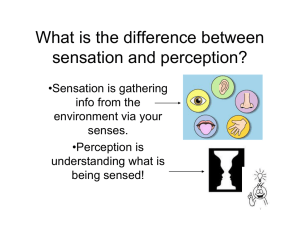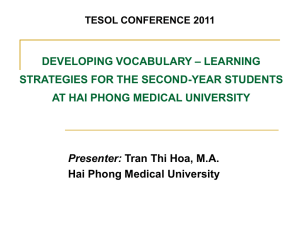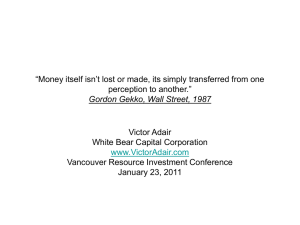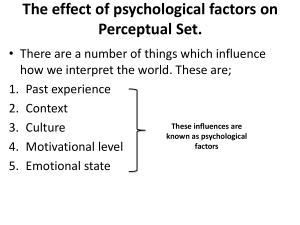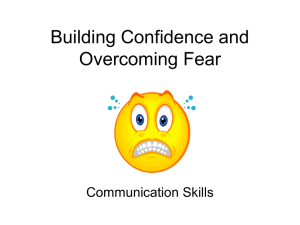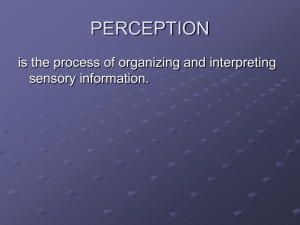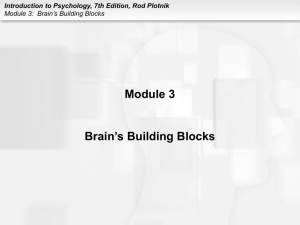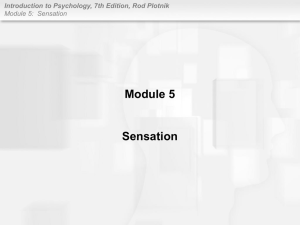Introduction to Psychology, 7th Edition, Rod Plotnik Module 6
advertisement
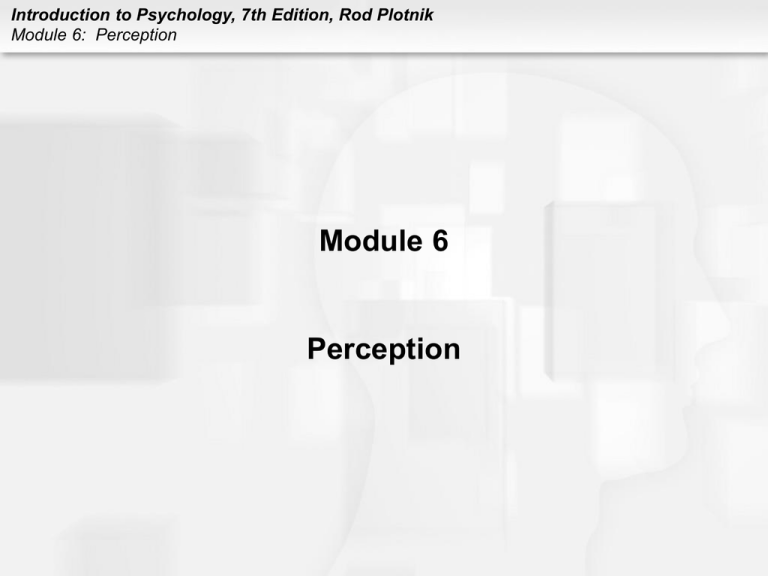
Introduction to Psychology, 7th Edition, Rod Plotnik Module 6: Perception Module 6 Perception Introduction to Psychology, 7th Edition, Rod Plotnik Module 6: Perception PERCEPTUAL THRESHOLDS • Becoming aware of a stimulus – Gustav Fechner • defined the absolute threshold as the smallest amount of stimulus energy (such as sound or light) that can be observed or experienced – Absolute threshold • the intensity level of a stimulus such that a person will have a 50% chance of detecting it • Example: Reading mammograms-lowering the threshold Introduction to Psychology, 7th Edition, Rod Plotnik Module 6: Perception p122 THRESHOLD GRAPH Introduction to Psychology, 7th Edition, Rod Plotnik Module 6: Perception PERCEPTUAL THRESHOLDS (CONT.) • E. H. Weber – worked on the problem of how we judge whether a stimulus, such as loud music, has increased or decreased in intensity (Ex. Frog in a boiling pot/Al Gore-Global warming) – concept of just noticeable difference (JND) – refers to the smallest increase or decrease in the intensity of a stimulus that a person is able to detect • Weber’s law – The increase in intensity of a stimulus needed to produce a just noticeable difference grows in proportion to the intensity of the initial stimulus. Introduction to Psychology, 7th Edition, Rod Plotnik Module 6: Perception SENSATION VERSUS PERCEPTION • Basic Differences – Sensations • Direct input/basic information • our first awareness of some outside stimulus • Tell you something is there – Perceptions • Adds meaning and organization • Tells you what it is Introduction to Psychology, 7th Edition, Rod Plotnik Module 6: Perception SENSATION VERSUS PERCEPTION (CONT.) • Changing sensation into perception – Stimulus • change of energy in the environment, such as light waves, sound waves, mechanical pressure, or chemicals – Transduction • change physical energy into electrical signals • electrical signals are changed into impulses that travel into the brain – Brain • impulses from senses first go to different primary areas of the brain each of us has a unique set of personal experiences, emotions, and memories that are automatically added to our perceptions by other areas of the brain Introduction to Psychology, 7th Edition, Rod Plotnik Module 6: Perception RULES OF ORGANIZATION • Structuralist versus Gestalt psychologists – Structuralists • believed that you add together hundreds of basic elements to form complex perceptions – Gestaltists • believe our brains follow a set of rules that specify how individual elements are to be organized into a meaningful pattern, or perception Introduction to Psychology, 7th Edition, Rod Plotnik Module 6: Perception RULES OF ORGANIZATION (CONT.) • Organizational rules – rules of organization: identified by Gestalt psychologists • how our brains combine and organize individual pieces or elements into a meaningful perception Figure-ground • we automatically distinguish between a figure and a ground Similarity • we group together elements that appear similar Introduction to Psychology, 7th Edition, Rod Plotnik Module 6: Perception RULES OF ORGANIZATION (CONT.) • Organizational rules Closure • we fill in any missing parts of a figure and see the figure as complete Proximity • we group together objects that are physically close to one another Simplicity • stimuli are organized in the simplest way possible Continuity • we favor the smooth or continuous paths when interpreting a series of points or lines Introduction to Psychology, 7th Edition, Rod Plotnik Module 6: Perception PERCEPTUAL CONSTANCY • Size, shape, brightness & color constancy Size constancy • To perceive objects as remaining the same size even when their images on the retina are continually growing or shrinking Shape constancy • To perceive an object as retaining its same shape even though when we view it from different angles, its shape is continually changing its image on the retina Introduction to Psychology, 7th Edition, Rod Plotnik Module 6: Perception PERCEPTUAL CONSTANCY (CONT.) • Size, shape, brightness & color constancy Brightness constancy • To perceive brightness as remaining the same in changing illumination Color constancy • To perceive colors as remaining stable despite differences in lighting Introduction to Psychology, 7th Edition, Rod Plotnik Module 6: Perception DEPTH PERCEPTION • Binocular (two eyes) depth cues – Depth perception • refers to the ability of your eye and brain to add a third dimension, depth, to all visual perceptions, even though images projected on the retina are in only two dimensions, height, and width – Binocular depth cues • depends on the movement of both eyes – Convergence • refers to a binocular cue for depth perception based on signals sent from muscles that turn the eyes Introduction to Psychology, 7th Edition, Rod Plotnik Module 6: Perception p129 RETINAL DISPARITY Introduction to Psychology, 7th Edition, Rod Plotnik Module 6: Perception DEPTH PERCEPTION (CONT.) • Monocular depth cues – produced by signals from a single eye Linear perspective • monocular depth cue that results as parallel lines come together, converge, in the distance Relative size • monocular depth cue that results when we expect two objects to be the same size and they are not Interposition • monocular depth cue that comes into play when objects overlap Introduction to Psychology, 7th Edition, Rod Plotnik Module 6: Perception DEPTH PERCEPTION (CONT.) • Monocular depth cues – Light and shadow • monocular depth cues where brightly lit objects appear closer, while objects in shadows appear farther away – Texture gradient • monocular depth cue in which areas with sharp, detailed texture are interpreted as being closer and those with less sharpness and poorer detail are perceived as more distant Introduction to Psychology, 7th Edition, Rod Plotnik Module 6: Perception DEPTH PERCEPTION (CONT.) • Monocular depth cues – Atmospheric perspective • monocular depth cue that is created by the presence of dust, smog, clouds, or water vapor – Motion parallax • monocular depth cue based on the speed of moving objects Introduction to Psychology, 7th Edition, Rod Plotnik Module 6: Perception ILLUSIONS • Strange perceptions – Illusion • a perceptual experience in which you perceive an image as being so strangely distorted that, in reality, it cannot and does not exist – Impossible figure • perceptual experience in which a drawing seems to defy basic geometric laws Introduction to Psychology, 7th Edition, Rod Plotnik Module 6: Perception p132 IMPOSSIBLE FIGURE Introduction to Psychology, 7th Edition, Rod Plotnik Module 6: Perception EXTRASENSORY PERCEPTION • Definition – a group of psychic experiences that involve perceiving or sending information (images) outside normal sensory processes or channels • Four general abilities – telepathy – ability to transfer one’s thoughts to another or to read the thoughts of others – precognition – ability to foretell events Introduction to Psychology, 7th Edition, Rod Plotnik Module 6: Perception EXTRASENSORY PERCEPTION (CONT.) • Clairvoyance – ability to perceive events or objects that are out of sight • Psychokinesis – ability to exert mind over matter; moving objects Introduction to Psychology, 7th Edition, Rod Plotnik Module 6: Perception EXTRASENSORY PERCEPTION • • • • Select a random number with 3 digits The first digit must be larger than the last Reverse the number Subtract it from itself 845 - 548 297 Write 0-9 on the board Start with 9 and add 90, then 91 099 594 198 693 297 792 396 891 495 990


